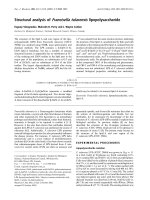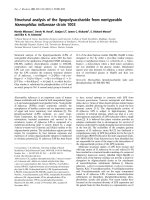Báo cáo y học: "cGlobal analysis of microRNA target gene expression reveals the potential roles of microRNAs in maintaining tissue identity" ppsx
Bạn đang xem bản rút gọn của tài liệu. Xem và tải ngay bản đầy đủ của tài liệu tại đây (1.12 MB, 47 trang )
Genome Biology 2005, 6:P14
Deposited research article
Global analysis of microRNA target gene expression reveals the
potential roles of microRNAs in maintaining tissue identity
Zhenbao Yu, Zhaofeng Jian, Shi-Hsiang Shen, Enrico Purisima, and Edwin
Wang
Addresses: Biotechnology Research Institute, National Research Council of Canada, Montréal, Québec, H4P 2R2, Canada.
Correspondence: Edwin Wang. E-mail: Zhenbao Yu. E-mail:
comment
reviews
reports
deposited research
interactions
information
refereed research
.deposited research
AS A SERVICE TO THE RESEARCH COMMUNITY, GENOME BIOLOGY PROVIDES A 'PREPRINT' DEPOSITORY
TO WHICH ANY ORIGINAL RESEARCH CAN BE SUBMITTED AND WHICH ALL INDIVIDUALS CAN ACCESS
FREE OF CHARGE. ANY ARTICLE CAN BE SUBMITTED BY AUTHORS, WHO HAVE SOLE RESPONSIBILITY FOR
THE ARTICLE'S CONTENT. THE ONLY SCREENING IS TO ENSURE RELEVANCE OF THE PREPRINT TO
GENOME BIOLOGY'S SCOPE AND TO AVOID ABUSIVE, LIBELLOUS OR INDECENT ARTICLES. ARTICLES IN THIS SECTION OF
THE JOURNAL HAVE NOT BEEN PEER-REVIEWED. EACH PREPRINT HAS A PERMANENT URL, BY WHICH IT CAN BE CITED.
RESEARCH SUBMITTED TO THE PREPRINT DEPOSITORY MAY BE SIMULTANEOUSLY OR SUBSEQUENTLY SUBMITTED TO
GENOME BIOLOGY OR ANY OTHER PUBLICATION FOR PEER REVIEW; THE ONLY REQUIREMENT IS AN EXPLICIT CITATION
OF, AND LINK TO, THE PREPRINT IN ANY VERSION OF THE ARTICLE THAT IS EVENTUALLY PUBLISHED. IF POSSIBLE, GENOME
BIOLOGY WILL PROVIDE A RECIPROCAL LINK FROM THE PREPRINT TO THE PUBLISHED ARTICLE.
Posted: 19 December 2005
Genome Biology 2005, 6:P14
The electronic version of this article is the complete one and can be
found online at />© 2005 BioMed Central Ltd
Received: 13 December 2005
This is the first version of this article to be made available publicly.
This article was submitted to Genome Biology for peer review.
This information has not been peer-reviewed. Responsibility for the findings rests solely with the author(s).
1
GlobalanalysisofmicroRNAtargetgeneexpressionrevealsthepotentialrolesof
microRNAsinmaintainingtissueidentity
ZhenbaoYu
*
,ZhaofengJian,Shi-HsiangShen,EnricoPurisima,andEdwinWang
*
BiotechnologyResearchInstitute,NationalResearchCouncilofCanada,Montréal,
Québec,H4P2R2,Canada
*
CorrespondenceshouldbeaddressedtoE.W.()andZ.Y.
(
)
2
Abstract
Background:MicroRNAsarenon-codingsmallRNAsof~22nucleotidesthatregulate
thegeneexpressionbybase-paringwithtargetmRNAs,leadingtomRNAcleavageor
translationalrepression.ItiscurrentlyestimatedthatmicroRNAsaccountfor~1%of
predictedgenesinhighereukaryoticgenomesandthatupto30%ofgenesmightbe
regulatedbymicroRNAs.However,onlyveryfewmicroRNAshavebeenfunctionally
characterizedandthegeneralfunctionsofmicroRNAsarenotgloballystudied.
Results:WesystematicallyanalyzedtheexpressionpatternsofmicroRNAtargetsusing
severalpublicmicroarrayprofilesandfoundthattheexpressionlevelsofmicroRNA
targetsaresignificantlylowerinallmouseandDrosophilatissuesthanintheembryos
andthatmicroRNAtargetsaredramaticallyexcludedfromthetissue-specifically
expressedgenegroups.
Conclusion:TheseresultsstronglysuggestthattheglobalfunctionsofmicroRNAsare
largelyinvolvedindrivingtissuedifferentiationandmaintainingtissueidentityrather
thanintissue-specificphysiologicalfunctions.Inaddition,thesefindingsimplythat
disruptionofmicroRNAfunctionsmightcausedelineationofdifferentiatedcells,a
crucialsteptowardscarcinogenesis.
3
Background
MicroRNAs(miRNAs),encodedinthechromosomalDNAandtranscribedaslonger
stem-loopprecursors,termedpri-miRNAs,arenon-codingsmall(21-23nucleotide)
RNAsthatregulatetheexpressionoftargetmRNAs(reviewedin[1-4]).Upon
transcription,pri-miRNAisconvertedtomaturemiRNAduplexthroughsequential
processingbyRNaseIIIfamilyofendonucleasesDroshaandDicer[3,4].Onestrand
of
theprocessedduplexisincorporatedintoasilencingcomplex
andguidedtotarget
sequencesbybase-pairing(reviewedin[5,6]).Thisresultsinthe
cleavageoftarget
mRNAsorrepressionoftheirproductive
translation[5,6].Inthepastfewyears,several
hundredmiRNAswereidentifiedinanimalsandplants[7-18].Itiscurrentlyestimated
thatmiRNAsaccountfor~1%ofpredictedgenesinhighereukaryoticgenomes[19].
DespitethelargenumberofidentifiedmiRNAs,onlyahandfulofthemhavebeen
functionallycharacterized.Forexample,lin-4andlet-7regulatethetimingoflarval
developmentinC.elegans[20,21].Lsy-6andmiR-273actsequentiallytocontrolthe
left/rightasymmetricgeneexpressioninC.eleganschemosensoryneurons[22].Bantam
promotescellproliferationandinhibitsapoptosisinDrosophila[23].MiR-14suppresses
celldeathandregulatesfatmetabolism[24].MiR-181potentiatesB-celldifferentiation
[25].Thesefindings,togetherwiththecomplicatedexpressionpatternsandlargenumber
ofpredictedtargets,implythatmiRNAsmayregulateabroadrangeofphysiologicaland
developmentalprocesses.
4
IdentificationofthetargetsofeachmiRNAiscrucialforunderstandingthebiological
functionofmiRNAs.Accumulatingempiricalevidencehasrevealedtheimportanceof
the5-terminalsegmentofmiRNAswith6-8nucleotidesinlength,called“seed”region,
formiRNAfunction[26-29].Forexample,systematicalsinglenucleotidemutation
studiesdemonstratedthatbase-pairingofmiRNAstotheirtargetswith7nucleotidesat
the5-terminusofmiRNAsfromposition2toposition8isessentialandsometimes
sufficientformiRNAstoknockdowntheirtargetexpression[26].Basedonthese
discoveries,severalcomputationalmethodshavebeendevelopedtosearchformiRNA
targets[30-39].Mostofthesemethodshavebeenbiologicallyvalidatedandprovedtobe
veryefficientandaccurate.Theaccuracyofthesemethodshasalsobeenprovedbylarge
scalegeneexpressionprofilestudies[40,41].Inonestudy,Limetal.[40]reportedthat
transfectionsofmiR-1andmiR-124intoHeLacellsrespectivelycauseddown-regulation
oflargenumbersoftargetmRNAsandmajority(76%and88%respectively)ofdown-
regulatedmRNAsshowedasegmentwith6nucleotidescomplementarytothe5’-
terminusofthetransfectedmiRNAs(the“seed”sequence).Inanotherstudy,Krutzfeldt
etal.[41]demonstratedthatknockdownofmiRNA-122byintravenousadministrationof
miRNA“antagomirs”ledtoupregulationanddownregulationofalargenumberofgenes
inliver.Theyfoundthatthe3’-untranslatedregionsofupregulatedgenesarestrongly
enrichedinmiRNA-122“seed”-matchmotifs,whereasdownregulatedgenesaredepleted
inthesemotifs[41].
Thesemethodshaveyieldedalargenumberofcandidatetargetsinbothplantsand
animals.TheestimatedhumanmiRNAtargetscanaccountforuptoonethirdofhuman
5
genes[35].ThediversityandabundanceofmiRNAtargetsreflectthatmiRNAsandtheir
targetsappeartoformacomplexregulatorynetwork.Forexample,asinglemiRNAcan
regulatehundredsofmRNAsandasinglemRNAcanbetargetedbyseveraldifferent
miRNAs.
Basedonitsbiochemicalfunction,thebiologicalfunctionsofamiRNAshoulddepend
onthecombinationofitsactiontoeachofallitstargetsfortheirexpression.
Theoretically,thetissueswithlowleveloftheexpressionofthetargetsofamiRNAare
probablythetissuesinwhichthemiRNAisfunctionallyinvolved.Systematicalanalysis
ofgeneexpressionprofileshasbeenprovedtobevaluableforstudiesondiverse
biologicalprocesses[42-48].TounderstandtheglobalroleofthesenumerousmiRNAs,
weundertookaglobalanalysisoftheexpressionofmRNAtargetsinhuman,mouseand
Drosophilausingseveralpublicdatasets[49-51].Wefoundthattheexpressionlevelsof
miRNAtargetsaresignificantlylowerinallmouseandDrosophilatissuesthaninthe
embryos.Wealsofoundthatthepercentageofthenumberoftissue-specifically
expressedmiRNAtargetsissignificantlylowerthanthatofubiquitouslyexpressed
miRNAtargets.ThesefindingsstronglysuggestthatmiRNAsplayamostimportantrole
indrivingtissueterminaldifferentiationandparticularlyinmaintainingtissueidentity
ratherthanindeterminingorregulatingtissue-specificphysiologicalfunctions.
6
Results
ExpressionlevelofmiRNAtargetsistissue-dependent
SincemiRNAfunctiondependsonthecombinationofitsactionstoeachofallitstargets
fortheirexpression,tounderstandtheglobalroleofthesenumerousmiRNAs,we
undertookaglobalanalysisoftheexpressionofmRNAtargetsinhuman,mouseand
Drosophilausingseveralpublicdatasets.Wefirstanalyzedthemicroarrayexpression
datacontaining~10,000genesover41humantissuespublishedbyJohnsonetal.[50].
WecomparedtherelativeexpressionlevelofthetotaltargetsofindividualmiRNAs
acrossthe41humantissues.ForeachmiRNA,wecouldfindthetissuesinwhichits
functionsmaybeinvolvedbysearchingforthetissueswhichhavelowerexpressionlevel
ofitstotaltargets.SinceeachmiRNAhasmanytargetsandtheabsoluteexpression
levelsofthesetargetsareverydifferent,tomakeeachtargetequallycontributetothe
comparison,wefirstrankedeachgeneover41humantissuesaccordingitsexpression
levelsintherespectivetissues(seemethods).Alowerranknumbermeansalower
expressionlevel.ForeachmiRNA,ineachtissue,wecountedthenumberofitstargets
[35]ateachrankposition(TableS1).Bycomparingthedistributionoftheranknumber
ofthetargetsbetweendifferenttissues,wecouldfindtherelativeexpressionlevelsofthe
totaltargetsofamiRNAineachtissuecomparedtoothertissues.Thismethodcould
avoidtheeffectofthebiasoftheabsoluteexpressionlevelsofthemiRNAtargetsonthe
analysis.Figure1ashowsatypicalresultforthedistributionoftheranknumberofmiR-
128atargets[35]inliverandbrain.Inliver,thenumberofmiR-128atargetswithalower
ranknumberisobviouslymorethanthatofthosewithahigherranknumber.Incontrast,
inbrain,theresultisreversed.ThissuggeststhattheoverallexpressionlevelofmiR-
7
128atargetsinliverislowerthanthatinbrain.Toobtainaquickoverview,wegrouped
thetargetsintotwosets,onewithranknumbersfrom1-20andtheotherwithrank
numbersfrom22-41(seeinsetinFigure1a).WethencalculatedtheRRvalue(see
Methods),N
Rank1-20
/N
Rank22-41
.AhigherRRvaluemeanslowerexpressionlevelofthe
miRNAtargets.ARRvaluemorethanonesuggeststhattheexpressionlevelofthe
targetsofamiRNAinatissueismostlikelytobelowerthanthemedianexpressionlevel
ofthetargetsinalltissues.Forexample,theRRvalueformiR-128ais2.1(197targets/
92targets)inliverand0.57(104targets/184targets)inbrain,suggestingalower
expressionlevelofthemiR-128atargetsinliverthanthatinbrain.Totally,weanalyzed
55miRNAs,eachofwhichhaveatleast55targetspresentedinthemicroarraydataset
(average180targets/miRNA),across41tissues.Wealsodidthesameanalysisfortotal
genespresentinthemicroarraydataset.TheRRvaluesareshowninTableS1.TheRR
valueoftargetgenesforeachmiRNAinatissuewasnormalizedbytheRRvalueoftotal
genesinthesametissueandthenplottedasafunctionofmiRNAsandtissues
respectively(Figure1band1c).Asexpected,foreachindividualmiRNA,theRRvalues
indifferenttissuesareequallydistributedaroundone(thenumberofthetissueswitha
RRvaluemorethanoneissimilartothenumberofthetissueswithaRRvaluelessthan
one)(Figure1B).ForeachmiRNA,thetissueswithhighestRRvaluescouldbefound
fromthisfigureandTableS1,andtheyaremostlikelytobethetissuesinwhichthis
mRNAisfunctionallyinvolved.
However,whenwelookedatthedistributionoftheRRvaluesineachtissue(Figure1c),
tooursurprise,wefoundadramaticdifferencebetweendifferenttissues.Insometissues,
8
thepreponderanceofmiRNAshaveaRR>1.Conversely,insometissues,RR<1foran
overwhelmingfractionofthemiRNAs.Thissuggeststhattheoverallexpressionlevelof
miRNAtargetsisquitedepletedinsometissuesandenhancedinothers.Forexample,in
bonemarrow,54ofthe55miRNAshaveaRRvaluemorethanone,whereasinbrain,
noneofthemhasaRRvaluemorethanone,indicatingthattheoverallexpressionlevel
ofmiRNAtargetsinbonemarrowislowerthanthatinbrainnomatterwhichmiRNAit
is.SimilarresultswereobtainedwhenusingthemiRNAtargetspublishedbyJohnetal.
[31](FigureS1).
ExpressionlevelsofmiRNAtargetsarelowerindifferentiatedtissuesthanin
embryosinbothmammalianandfly
WenextanalyzedtheexpressionofmiRNAtargetsin55mousesamplesusingthegene
expressionprofiledatapublishedbyZhangetal.[51]andthedatasetofmicroRNA
targetspublishedbyJohnetal.[31].Similartowhatwefoundinhumantissues,theRR
valueforallofthe141miRNAsinmousebonemarrowisgreaterthanone(Figure.2a),
suggestingthattheexpressionlevelofmiRNAtargetsinthistissueisobviouslylower
thanthemedianlevelacrosstheothertissues.Asimilarresultwasobservedinother
hematopoiticcells-richorlymphocytes-richtissues,suchasthymus,spleenandlymph
node(Figure2band2c).Interestingly,wefoundanobviouscorrelationofthe
distributionpatternofRRvaluesandtheclusteroftissueproperty(Figure2band2c).
Mostimportantly,theexpressionlevelsofmiRNAtargetsinembryo,embryoheadand
placentaaresignificantlyhigherthanthatinothertissues(Figure2band2c).For
example,in12.5-dayembryo,allofthe141miRNAshaveaRR
valuebelowone.
9
Tofurtherconfirmtheobservation,wedirectlycomparedtheaverageexpressionvalueof
thetotal2276miRNAtargetsinthemousetissues.Consistingwiththeresultabove
derivedfromrankinganalysis,theaverageexpressionlevelofmiRNAtargetgenesis
higherin12.5-dayembryothanthatinanytissuesexceptforthe14.5-dayembryohead
andcortex(Figure3).Forexample,thelevelsinbonemarrow,spleen,thymusandlymph
nodearerespectivelymorethantwotimeslowerthanthatin12.5-dayembryo.
Wethenfocusedonthecomparisonofmousetissuestoembryo.Todoso,wecounted
thetotalnumberofmiRNAtargetswhoseexpressionlevelislowerinagiventissuethan
thatin12.5-dayembryo(N
<E12.5
)anddivideditbythetotalnumberofmiRNAtargets
whoseexpressionlevelishigherthanthatin12.5-dayembryo(N
>E12.5
).Asshownin
Figure4a,inalltissuesexceptfor14.5-dayembryohead,thelowerexpressedtarget
numberismorethanhigherexpressedtargetnumber(N
<E12.5
/N
>E12.5
>1).Asacontrol,
wecarriedoutthesamecalculationsforallgenes.Weseethat,foralltissues,theN
<E12.5
/
N
>E12.5
valueoftotalgenesislowerthanthatofmiRNAtargets(Figure4a).Resembling
statisticaltests(see“Methods”fordetails)demonstratedthatthedifferenceissignificant
(P<0.0002foralmostallofthetissues,TableS2).Tofurtherconfirmtheobservation,we
performedthesameanalysiswiththetotalmiRNAtargetspublishedbyLewisetal.[35]
andKreketal.[33]respectively.Wefoundthesimilarpatterns(Figure4band4c).
Figure4DshowsthatthedataobtainedusingeachsetofthemiRNAtargetspublishedby
eachofthethreegroupsarehighlycorrelated.Thissupportsboththequalityofthe
originaldataandouranalysismethod.
10
Takentogether,theoverallexpressionlevelofmiRNAtargetsineverydifferentiated
mousetissuesislowerthanthatinmouseembryo,suggestingthatmiRNAsmayplayan
importantrolefordeterminingthefateoftissuedifferentiationduringembryo
development,andmaintainingthetissueidentityinthelaterstage.
Todetermineiftheobservedexpressionpatternisconservedinotherspecies,we
analyzedthepublishedgeneexpressionprofileover75stagesofthewholelifecycleof
Drosophila[49].AsshowninFigure5aand5b,comparedto23-24hembryo,whilethe
ratiooflowerexpressedmiRNAtargetstohigherexpressedmiRNAtargetsremainsthe
sameduringembryoperiod,itdramaticallyincreasesstartingfromlarvalperiodsand
lastingtoadulthood(p<0.0002foralllarvaandmaleadult,seeTableS3formore
details).Thereisaclearcorrespondence(R=0.93)betweenthedatacalculatedusingthe
targetsetspublishedbyEnrightetal.[30]andStarketal.[30,30,38]respectively(Figure
5c).ThisdatastronglysuggestthatmiRNAsplayimportantrolesfordeterminingthe
timingoftissuedifferentiationduringlarvaperiodofDrosophiladevelopmentand
maintainingthetissueidentityduringtheadulthood.
Itshouldbenotedthatthehumanmicroarraydataset[50]weusedinthisstudydoesnot
containhumanembryoandalargescalegeneexpressionprofilecontaininghuman
embryoisnotavailable.Consequently,wecouldnotperformthecomparisonofthe
expressionlevelsofhumanmiRNAtargetsbetweenhumantissuesandhumanembryos.
11
MiRNAsmorefrequentlytargetubiquitouslyexpressedgenesthantissue-specific
genes
TodetermineifmiRNAsareinvolvedintissue-specificphysiologicalfunctions,we
analyzedthetissue-specificityofmiRNAtargetexpressionusingthemicroarraydata
representing21622mousegenes[51]including2276predictedmiRNAtargets[31].Each
ofthesegeneswasexpressedinatleastoneofthe55mousetissues[51].Boththe21622
genesandthe2276miRNAtargetswereclassifiedinto55groupsaccordingtothe
numberoftissues(between1to55)inwhichthegenewasexpressed.Wecountedthe
numbersofmiRNAtargetsandtotalgenesineachgrouprespectively.Todetermineif
themiRNAtargetsareenrichedinorexcludedfromsomegroups,wecomparedthe
percentageofmiRNAtargetstothetotalgenesineachgroupwiththepercentage
(10.5%)ofthetotalmiRNAtargets(2276)tothetotalgenes(21622).AsshowninFigure
6,amongthegenesthatareexpressedubiquitously,thetargetsofmiRNAsareover-
represented.Forexample,ingenesfoundingroups45-55(i.e.,genesfoundinalmostall
thetissues),approximately20%aremiRNAtargets,aroundtwicethefractionofmiRNA
targetsinthewholelistofgenes(10.5%).Incontrast,amonggenesthatareexpressedin
asmallnumberoftissues,miRNAtargetsareunder-represented.Forexample,amongthe
genesthatarespecificallyexpressedinonly1-4tissues,thefractionofmiRNAtargets
presentisabouthalforlessthanthatinthegeneralgenepopulation.Sincetissue-
specificallyexpressedgenesaremostlyinvolvedintissue-specificphysiological
functions,thisobservationsuggeststhatmiRNAsarepreferablyinvolvedindetermining
andmaintainingtissueidentityratherthanplayingatissue-specificphysiologicalrole.By
12
thatwemeanthetargetsofmiRNAsarecommontomosttissues.Amongthedifferent
tissues,varyingcombinationsofthesecommongenesaresuppressedbythemiRNA
resultinginthespecifictissuetype.Asananalogy,thecommongenesarelikeastarting
blockofmarblewiththemiRNAsbeingthesculptorthatchiselsawayeverythingthatis
notneededforthefinalfigure.
13
Discussion
Inthisstudy,wedevelopedamethodfortheanalysisoftheglobalexpressionpatternsof
miRNAtargets.Inthismethod,weconsideredthebiasoftheabsoluteexpressionlevels
ofeachmiRNAtargetsandlimiteditseffectonthecalculationbyrankingeachgeneover
allsamplesaccordingitsexpressionlevelsintherespectivetissuesandcountingthetotal
numberoftargetsateachrankingposition.BycomparingtheRRvaluesdefinedinthis
studybetweeneachsamples,weareabletofindthetissuesinwhichmiRNAtargetsare
lessexpressed.BasedonthebiochemicalfunctionofmiRNAs,thetissueswithlowest
expressionlevelsofitstargetsarelikelytobethetissuesinwhichamiRNAis
functionallyinvolved.Therefore,inthisstudy,wefirstprovideatoolfortheprediction
ofmiRNAfunctionsthroughanalysisoftheirtargetexpression.
Moreimportantly,wefoundthattheexpressionlevelofmiRNAtargetsindifferentiated
tissuesissignificantlylowerthanthatinembryosinbothmammalianandflyandthat
miRNAsmorefrequentlytargetubiquitouslyexpressedgenesthantissue-specificgenes.
ThesefindingsstronglysuggestthatmiRNAsplayamostimportantroleindrivingtissue
terminaldifferentiationandmaintainingtissueidentityratherthanindeterminingor
regulatingtissue-specificphysiologicalfunctions.Previousstudiessuggestthat10%to
30%ofhumangenesarepotentialmiRNAtargets[31,34].However,analysisofthe
specificgeneontology(GO)molecularfunctionclassificationamongthepredicted
targetscouldnotrevealanyspecificbiologicalfunctionsofanimalmiRNAssincethe
animalmiRNAtargetspopulatedmanyGOfunctionalcategories[31,34].Only~13%of
mammalianmiRNAtargetspredictedbyLewisetal.wereinvolvedindevelopment
14
accordingtotheGObiologicalprocesscategories[34].Failingtopredictthefunctionsof
miRNAtargetsthroughGOanalysismaybesimplycausedbytheevolvingstageofthe
classificationofGOfunctioncategories.Alternatively,onprinciple,thefunctionsof
miRNAscouldnotbepredictedbytheGOfunctioncategoriesoftheirtargetsbecausethe
expressionandthereforethefunctionsoftheirtargetsareproposedtobeturneddownbut
notinducedbymiRNAexpressionandGOanalysiscanonlytellthefunctionofagroup
ofgenesinaGOfunctioncategorywhentheyareexpressedorup-regulatedbutnotthat
whentheyaredown-regulated.Ourstudiesdemonstratethatstatisticalanalysisofthe
expressionofmiRNAtargetscanreflecttheglobalfunctionsofmiRNAs.The
statisticallylowerexpressionlevelofmiRNAtargetsinmaturedtissuesthaninembryo
demonstratesthatmiRNAsplayanimportantrolenotonlyfordeterminingtissuefate
duringembryodevelopmentbutalsoformaintainingidentityandpreventing
dedifferentiationofmaturedtissues.
OurstudiesalsodemonstratethattheoverallexpressionlevelsofmiRNAtargetscould
beclusteredinlargepartaccordingtotheiranatomiclocationsorphysiologicalfunctions.
Forexample,theaverageexpressionlevelsofmiRNAtargetsinlymphoidandmyeloid
tissues(lymphnode,thymus,spleenandbonemarrow)aremuchlowerthanthatinmost
ofothertissues.ThisresultindicatesthatmiRNAsmightalsoplayaveryimportantrole
forthedifferentiationofhematopoitieticlineagefrommyeloidandlymphoidprogenitors
inadditiontothatforthedifferentiationoftissuesfromembryocells.
15
Uptonow,themolecularmechanismdeterminingthelowerexpressionlevelofmiRNA
targetsindifferentiatedtissuesthanthatinembryosremainstobeelucidated.One
potentialreasonisthatthemiRNAexpressionlevelislowerinembryos.Thisistruefor
zebrafish.Recently,Wienholdsetal.havereportedthatmostzebrafishmiRNAswerenot
detectedduringearlydevelopment[52].However,theresultsregardingtotheglobal
expressionpatternsofmiRNAsduringmouseorDrosophilaembryodevelopmentare
currentlynotavailablealthoughthedifferentialexpressionofmiRNAsindifferenttissues
wereclearlydemonstrated[53-62].AnotherpossibilityisthattheactivityofmiRNA
machineryislowerinembryosthaninothertissues.Forexample,Yangetal.[63]
reportedthatdicer,animportantproteinforbothmiRNAbiogenesisandmiRNA
function,startsexpressionin7-dayoldmouseembryosandremainsstablethrough17-
dayembryos.
Inthisstudy,wealsofoundthatmiRNAtargetsaresignificantlyenrichedinubiquitously
expressedgenesandlargelyexcludedfromtissue-restrictivelyexpressedgenes.This
resultimpliesthatmiRNAsplaylessimportantrolefortissue-specificphysiological
functions.Instead,themajorbiologicalfunctionofmiRNAsistodeterminethefateof
tissuedifferentiationandmaintainthetissueidentity.
OurstudyalsoindicatesthatreductionofmiRNAexpressionmightcausedelineationof
differentiatedcells,acrucialsteptowardscarcinogenesis.Thisisconsistentwiththe
recentdiscoveries[64,65].Forexample,morethan50%ofhumanmiRNAsarelocatedin
chromosomeregionsinvolvedinhumancancers[64].Mostrecently,miRNAexpression
16
profileshasrevealedthatmostofmiRNAshadlowerexpressionlevelsintumors
comparedwithnormaltissues[65].Hence,understandingtheglobalroleofmiRNAsin
maintaininglineageofdifferentiatedtissuesandcellshasgreatimpactonthestudiesof
miRNAsincancergenetics.
17
Methods
Datasetsusedinthisstudy
ThedatasetsusedinthisstudyincludetwocompletelistsofhumanmiRNAtargets
publishedbyLewisetal.[35]andJohnetal.[31],threecompletelistsofmousemiRNA
targetspublishedbyJohnetal.[31],Lewisetal.[35]andKreketal.[33],twocomplete
listsofDrosophilamiRNAtargetspublishedbyEnrightetal.[30]andStarketal.
[30,30,38],amicroarrayexpressiondatasetformorethan10,000humangenesin41
tissuesand
celllines[50],amicroarrayexpressiondatasetfornearly40,000knownand
predictedmRNAsin55mousetissues[51]andamicroarrayexpressiondatafornearly
one-thirdofallDrosophilagenesduringthewholelifecycle[49,51].
RankingofmiRNAtargetgenes
TostudythecorrelationoftheexpressionofmiRNAsandtheirtargets,weanalyzedthe
microarrayexpressiondatacontaining~10,000genesover41humantissuespublished
byJohnsonetal.[50]byrankingeachgeneoveralltissuesaccordingtoitsexpression
levelintherespectivetissueasdescribedpreviously[40].Forexample,ifageneis
expressedlessinadefinedtissuethaninanyothertissues,theranknumberofthisgene
inthistissueis1.Similarly,ranknumber41meansthattheexpressionlevelofagenein
atissueishigherthanthatinanyothertissues.ForeachmiRNA,wecollectedallofits
predictedtargetspresentedinthemicroarraydatasetandobtainedtheranknumberof
eachofitstargetsinanygiventissues.ThemiRNAtargetsweusedinthisanalysisare
18
fromthedatasetspublishedbyLewisetal.[34]andJohnetal.[31]respectively.On
average,180targetspermiRNAcouldbefoundinthemicroarraydataset.
Tofacilitateamoreglobalview,wealsogroupedthegenesintotwosets,onewithlower
halfofranknumbersandtheotherwithhigherhalf.Whenthereisanoddnumberof
ranks,themiddlemostrankisexcluded.Inourspecificexamplewith41tissuesamples,
onesetconsistsofranks1-20,andtheotherfrom22-41,excludingrank21.Forany
miRNAinanytissue,wecountedthetotalnumberofitstargetswithinlower-ranksetand
divideditbythetotalnumberofitstargetswithinhigher-ranksettoyieldthecalculated
rankratio,RR.Forexample,foramiRNAinthe41-tissueset,RR=N
Rank1-20
/N
Rank22-41
.
TheRRvalueisanindicatorofthepreferentialtissueexpressionofagivenmiRNA’s
targetgenes.AnRRvaluegreaterthanonemeansthatthemajorityofexpressedtargets
ofamiRNAinthistissuehavealowerexpressionlevelthanthemedianlevelof
expressionofthemiRNA’stargetsacrossallthetissues.IftheRR
valueofamiRNAis
greaterinaparticulartissuethanthatinanyothers,theexpressionlevelofthetargetsof
thismiRNAinthistissueisverylikelytobethelowestamongthe41humantissues.We
alsodidthesameanalysisfortotalgenespresentedinthemicroarraydataset.TheRR
valueoftargetgenesforeachmiRNAinatissuewasnormalizedbytheRRvalueoftotal
genesinthesametissueandthenplottedasafunctionoftissuesandmiRNAs
respectively.TheRRvalueprovidesaglobaldescriptorofthetissuedistributionofan
miRNA’stargetgenesratherthantheexpressionlevelsofindividualgenes.Itdoesnot
providegene-specificinformationbutallowstheextractionofglobaltrendsofagroupof
genes(miRNAtargetgenes)amidthenoisydataforindividualgenes.
19
Thismethodwasalsousedtoanalyzeamicroarraydatasetcontaining55mousesamples.
Inthiscase,RR=N
Rank1-27
/N
Rank29-55
.
ComparisonoftheexpressionlevelofmiRNAtargetsintheembryosofmouseand
Drosophilawiththatintheirtissues
TocomparetheexpressionlevelofmiRNAtargetsinmousetissueswiththatinmouse
embryo,wecountedthetotalnumbersofmiRNAtargetswhoseexpressionlevelislower
andhigherrespectivelyinadefinedtissuethanthatin12.5-dayembryo,andcalculated
theratiooflower-expressedtargetstothehigher-expressedtargets.Aratiomorethanone
meansthatthenumberoflower-expressedtargetsismorethanhigher-expressedtargets.
Toobtainthestatisticalsignificanceofthisratio,weperformedresamplingstatistical
tests.Ineachresampling,werandomlysub-pooledthesamenumberofgenesasthe
numberofmiRNAtargetsfromthepooloftotalgenesthatarelower-andhigher-
expressedgenesinadefinedtissuetotheembryo.Wecalculatedtheratiooflower-
expressedgenestothehigher-expressedgenesinthissub-poolanddefineditasR
random
.
WetestedthenullhypothesisR
random
≥R
mirna
byperforming5,000timesofresampling
tests.Werejectedthehypothesisifp<0.05.
AsimilarmethodwasusedtocomparetheexpressionofmiRNAtargetsinthedifferent
periodsofDrosophilalifecyclewith23-24hembryousingamicroarraydataset
publishedbyArbeitmanetal.[49,51],exceptthattheratioofnumberofmiRNAtargets
whoseexpressionlevelinadefinedperiodistwo-foldlowerthanthatin23-24hembryo
20
tothatofmiRNAtargetswhoseexpressionlevelistwotimeshigherthanthatin23-24h
embryowasrepresented.Thestatisticalanalysisforthissetwasconductedasdescribed
above.
Analysisofthetissue-specificityofmiRNAtargetexpression
UsingthemicroarraydatabasepublishedbyZhangetal.[51],whichcontains21622
mousegenesincluding2276predictedmiRNAtargets,weanalyzedthetissue-specificity
ofmiRNAtargetexpression.Themousegenesareclassifiedinto55groupsaccordingto
thenumberoftissues(1to55)inwhichagenewasexpressed.Thetotalnumbersof
miRNAtargetsandtotalgenesineachgroupwerecountedrespectively.Thepercentage
ofmiRNAtargetstothetotalgenesineachgroupwascalculatedandcomparedtothe
percentage(10.52%)ofthetotalmiRNAtargets(2276)tothetotalgenes(21622)for
determiningifthemiRNAtargetsareenrichedinorexcludedfromtherespectivegroup.
21
ReferenceList
1. AmbrosV:microRNAs:tinyregulatorswithgreatpotential.Cell2001,
107:823-826.
2. BartelDP:MicroRNAs:genomics,biogenesis,mechanism,andfunction.Cell
2004,116:281-297.
3. CullenBR:TranscriptionandprocessingofhumanmicroRNAprecursors.
MolCell2004,16:861-865.
4. KimVN:MicroRNAbiogenesis:coordinatedcroppinganddicing.NatRev
MolCellBiol2005,6:376-385.
5. CarmellMA,HannonGJ:RNaseIIIenzymesandtheinitiationofgene
silencing.NatStructMolBiol2004,11:214-218.
6. MeisterG,TuschlT:Mechanismsofgenesilencingbydouble-strandedRNA.
Nature2004,431:343-349.
7. Lagos-QuintanaM,RauhutR,LendeckelW,TuschlT:Identificationofnovel
genescodingforsmallexpressedRNAs.Science2001,294:853-858.
8. LauNC,LimLP,WeinsteinEG,BartelDP:AnabundantclassoftinyRNAs
withprobableregulatoryrolesinCaenorhabditiselegans.Science2001,
294:858-862.
9. LeeRC,AmbrosV:AnextensiveclassofsmallRNAsinCaenorhabditis
elegans.Science2001,294:862-864.
10. Lagos-QuintanaM,RauhutR,YalcinA,MeyerJ,LendeckelW,TuschlT:
Identificationoftissue-specificmicroRNAsfrommouse.CurrBiol2002,
12:735-739.
11. BentwichI,AvnielA,KarovY,AharonovR,GiladS,BaradO,BarzilaiA,Einat
P,EinavU,MeiriEetal.:Identificationofhundredsofconservedand
nonconservedhumanmicroRNAs.NatGenet2005,37:766-770.
12. BerezikovE,GuryevV,vandeBJ,WienholdsE,PlasterkRH,CuppenE:
Phylogeneticshadowingandcomputationalidentificationofhuman
microRNAgenes.Cell2005,120:21-24.
13. GradY,AachJ,HayesGD,ReinhartBJ,ChurchGM,RuvkunG,KimJ:
ComputationalandexperimentalidentificationofC.elegansmicroRNAs.
MolCell2003,11:1253-1263.
22
14. Jones-RhoadesMW,BartelDP:Computationalidentificationofplant
microRNAsandtheirtargets,includingastress-inducedmiRNA.MolCell
2004,14:787-799.
15. KimJ,KrichevskyA,GradY,HayesGD,KosikKS,ChurchGM,RuvkunG:
IdentificationofmanymicroRNAsthatcopurifywithpolyribosomesin
mammalianneurons.ProcNatlAcadSciUSA2004,101:360-365.
16. Lagos-QuintanaM,RauhutR,MeyerJ,BorkhardtA,TuschlT:NewmicroRNAs
frommouseandhuman.RNA2003,9:175-179.
17. LimLP,LauNC,WeinsteinEG,AbdelhakimA,YektaS,RhoadesMW,Burge
CB,BartelDP:ThemicroRNAsofCaenorhabditiselegans.GenesDev2003,
17:991-1008.
18. SunkarR,GirkeT,JainPK,ZhuJK:Cloningandcharacterizationof
microRNAsfromrice.PlantCell2005,17:1397-1411.
19. Griffiths-JonesS:ThemicroRNARegistry.NucleicAcidsRes2004,32:D109-
D111.
20. LeeRC,FeinbaumRL,AmbrosV:TheC.elegansheterochronicgenelin-4
encodessmallRNAswithantisensecomplementaritytolin-14.Cell1993,
75:843-854.
21. ReinhartBJ,SlackFJ,BassonM,PasquinelliAE,BettingerJC,RougvieAE,
HorvitzHR,RuvkunG:The21-nucleotidelet-7RNAregulatesdevelopmental
timinginCaenorhabditiselegans.Nature2000,403:901-906.
22. JohnstonRJ,HobertO:AmicroRNAcontrollingleft/rightneuronal
asymmetryinCaenorhabditiselegans.Nature2003,426:845-849.
23. BrenneckeJ,HipfnerDR,StarkA,RussellRB,CohenSM:bantamencodesa
developmentallyregulatedmicroRNAthatcontrolscellproliferationand
regulatestheproapoptoticgenehidinDrosophila.Cell2003,113:25-36.
24. XuP,VernooySY,GuoM,HayBA:TheDrosophilamicroRNAMir-14
suppressescelldeathandisrequiredfornormalfatmetabolism.CurrBiol
2003,13:790-795.
25. ChenCZ,LiL,LodishHF,BartelDP:MicroRNAsmodulatehematopoietic
lineagedifferentiation.Science2004,303:83-86.
26. BrenneckeJ,StarkA,RussellRB,CohenSM:PrinciplesofmicroRNA-target
recognition.PLoSBiol2005,3:e85.
27. DoenchJG,SharpPA:SpecificityofmicroRNAtargetselectionin
translationalrepression.GenesDev2004,18:504-511.
23
28. KiriakidouM,NelsonPT,KouranovA,FitzievP,BouyioukosC,MourelatosZ,
HatzigeorgiouA:Acombinedcomputational-experimentalapproachpredicts
humanmicroRNAtargets.GenesDev2004,18:1165-1178.
29. KloostermanWP,WienholdsE,KettingRF,PlasterkRH:Substrate
requirementsforlet-7functioninthedevelopingzebrafishembryo.Nucleic
AcidsRes2004,32:6284-6291.
30. EnrightAJ,JohnB,GaulU,TuschlT,SanderC,MarksDS:MicroRNAtargets
inDrosophila.GenomeBiol2003,5:R1.
31. JohnB,EnrightAJ,AravinA,TuschlT,SanderC,MarksDS:Human
MicroRNAtargets.PLoSBiol2004,2:e363.
32. KiriakidouM,NelsonPT,KouranovA,FitzievP,BouyioukosC,MourelatosZ,
HatzigeorgiouA:Acombinedcomputational-experimentalapproachpredicts
humanmicroRNAtargets.GenesDev2004,18:1165-1178.
33. KrekA,GrunD,PoyMN,WolfR,RosenbergL,EpsteinEJ,MacMenaminP,da
P,I,GunsalusKC,StoffelMetal.:CombinatorialmicroRNAtarget
predictions.NatGenet2005,37:495-500.
34. LewisBP,ShihIH,Jones-RhoadesMW,BartelDP,BurgeCB:Predictionof
mammalianmicroRNAtargets.Cell2003,115:787-798.
35. LewisBP,BurgeCB,BartelDP:Conservedseedpairing,oftenflankedby
adenosines,indicatesthatthousandsofhumangenesaremicroRNAtargets.
Cell2005,120:15-20.
36. RhoadesMW,ReinhartBJ,LimLP,BurgeCB,BartelB,BartelDP:Prediction
ofplantmicroRNAtargets.Cell2002,110:513-520.
37. RobinsH,LiY,PadgettRW:IncorporatingstructuretopredictmicroRNA
targets.ProcNatlAcadSciUSA2005,102:4006-4009.
38. StarkA,BrenneckeJ,RussellRB,CohenSM:IdentificationofDrosophila
MicroRNAtargets.PLoSBiol2003,1:E60.
39. WangXJ,ReyesJL,ChuaNH,GaasterlandT:Predictionandidentificationof
ArabidopsisthalianamicroRNAsandtheirmRNAtargets.GenomeBiol
2004,5:R65.
40. LimLP,LauNC,Garrett-EngeleP,GrimsonA,SchelterJM,CastleJ,BartelDP,
LinsleyPS,JohnsonJM:MicroarrayanalysisshowsthatsomemicroRNAs
downregulatelargenumbersoftargetmRNAs.Nature2005,433:769-773.
41. KrutzfeldtJ,RajewskyN,BraichR,RajeevKG,TuschlT,ManoharanM,Stoffel
M:SilencingofmicroRNAsinvivowith'antagomirs'.Nature2005.
24
42. CheungVG,SpielmanRS,EwensKG,WeberTM,MorleyM,BurdickJT:
Mappingdeterminantsofhumangeneexpressionbyregionalandgenome-
wideassociation.Nature2005,437:1365-1369.
43. HuminieckiL,WolfeKH:Divergenceofspatialgeneexpressionprofiles
followingspecies-specificgeneduplicationsinhumanandmouse.Genome
Res2004,14:1870-1879.
44. MorleyM,MolonyCM,WeberTM,DevlinJL,EwensKG,SpielmanRS,
CheungVG:Geneticanalysisofgenome-widevariationinhumangene
expression.Nature2004,430:743-747.
45. RifkinSA,HouleD,KimJ,WhiteKP:Amutationaccumulationassayreveals
abroadcapacityforrapidevolutionofgeneexpression.Nature2005,
438:220-223.
46. RodwellGE,SonuR,ZahnJM,LundJ,WilhelmyJ,WangL,XiaoW,Mindrinos
M,CraneE,SegalEetal.:Atranscriptionalprofileofaginginthehuman
kidney.PLoSBiol2004,2:e427.
47. StolcV,GauharZ,MasonC,HalaszG,vanBatenburgMF,RifkinSA,HuaS,
HerremanT,TongprasitW,BarbanoPEetal.:Ageneexpressionmapforthe
euchromaticgenomeofDrosophilamelanogaster.Science2004,306:655-660.
48. StuartJM,SegalE,KollerD,KimSK:Agene-coexpressionnetworkforglobal
discoveryofconservedgeneticmodules.Science2003,302:249-255.
49. ArbeitmanMN,FurlongEE,ImamF,JohnsonE,NullBH,BakerBS,Krasnow
MA,ScottMP,DavisRW,WhiteKP:Geneexpressionduringthelifecycleof
Drosophilamelanogaster.Science2002,297:2270-2275.
50. JohnsonJM,CastleJ,Garrett-EngeleP,KanZ,LoerchPM,ArmourCD,Santos
R,SchadtEE,StoughtonR,ShoemakerDD:Genome-widesurveyofhuman
alternativepre-mRNAsplicingwithexonjunctionmicroarrays.Science2003,
302:2141-2144.
51. ZhangW,MorrisQD,ChangR,ShaiO,BakowskiMA,MitsakakisN,
MohammadN,RobinsonMD,ZirngiblR,SomogyiEetal.:Thefunctional
landscapeofmousegeneexpression.JBiol2004,3:21.
52. WienholdsE,KloostermanWP,MiskaE,Alvarez-SaavedraE,BerezikovE,de
BruijnE,HorvitzHR,KauppinenS,PlasterkRH:MicroRNAexpressionin
zebrafishembryonicdevelopment.Science2005,309:310-311.
53. BabakT,ZhangW,MorrisQ,BlencoweBJ,HughesTR:ProbingmicroRNAs
withmicroarrays:tissuespecificityandfunctionalinference.RNA2004,
10:1813-1819.









